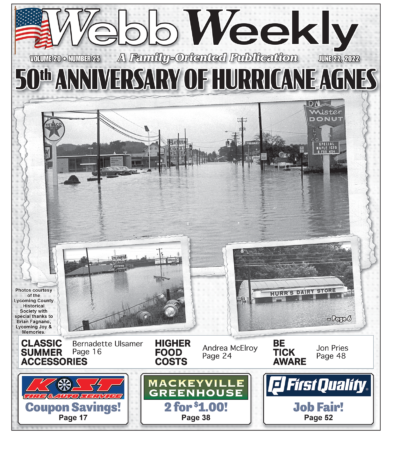During this week, 50 years ago, Lycoming County and the rest of the area of the Susquehanna River Basin were in the throes of the most destructive and severe flooding seen in the area up to that time. The flood was caused by heavy rains from June 20 to 24, 1972, from the remnants of Hurricane — and what had been downgraded to — Tropical Storm Agnes.
Agnes remains a touchstone memory for all who were alive at the time, and it is this flood that all subsequent flood events have been measured, including 1996 and 2011. It is an event that is recalled in a “where-were-you-when-it-happened” way, such as the JFK assassination and the September 11 terror attacks.
During that period, the Williamsport area had 15 inches of rain that came on top of an already sodden ground from a very wet April, May, and early June.
The Agnes Flood caused more than $2.2 billion in damage in Pennsylvania, which would be about $16 billion in today’s dollars. In Lycoming County, the damage amount was more than $100 million. Statewide, 50 lives were lost in the flood. In Lycoming County, two lives were lost. The waters of the Susquehanna came perilously close to going over the dikes in Williamsport at an unheard crest of 34.75 feet.
Webb Weekly looked back in 2012 at this landmark event that affected so many people and is remembered in various ways by them. We gathered the recollections of three men, one of which was my father, Lou Hunsinger Sr., who died in 2020, who was closely involved in helping with the Agnes Flood rescue effort and its aftermath.
Dennis Gruver is the Borough of Montgomery’s Director of Emergency Management and served in that same capacity during the 1972 Agnes Flood. The low-lying areas in the borough near the Susquehanna River and Black Hole Creek were hard hit by the flooding.
“The first call to Montgomery Emergency Management came early in the morning of June 22, 1972, to provide a boat to assist the fire department in the rescue of a family from a home next to Black Hole Creek close to the intersection of Route 54 and School House Road, Gruver told Webb Weekly. “Within a short amount of time, a large volume of water came down Black Hole Creek with a force that destroyed much of Hulsizer Chevrolet Company. The water came over their counters and broke the plate glass windows in the showroom. One emergency service volunteer almost lost his life in an attempt to rescue an elderly person from a home across from Hulsizer. After a short time, the surge had passed that area leaving a large amount of destruction to residential and commercial buildings.” As the water surge continued toward Montgomery Borough, the municipal water system located on Black Hole Creek — at the rear of a residence on North Main Street — was destroyed. The red barn is still standing on the site. The borough sewer system was damaged by the effects of the storm.
According to Gruver, Montgomery had one death from the flood. Albert “Baldy” Shick died while on duty as a fire policeman with the Montgomery Volunteer Fire Department. He was directing traffic at the intersection of Montgomery Street and Thomas Avenue as the water was on the rise.
Gruver said the Montgomery High School was the site of the mass care center, with 250 people housed and fed there for several days. With the Borough water and sewer system out of service, water from a well at the Dorsey Creveling residence at the top of West Houston Avenue was used to fill 18-gallon EMA cans which were delivered to the mass care center to flush and to cook. Also, water cans were set on street corners and residence porches.
“While I worked on the outside with volunteers from the Fire Dept, EMA, and others that just wanted to help with logistics, my wife Nancy headed up the mass care Red Cross operations inside the school with many volunteers,” Gruver recalled. “Several other events come to mind as the water was on the rise; it got into the control box for the crossing gates at the Pennsylvania Railroad crossing, and a warning bell rang for many hours until the equipment flooded out. The water flooded the control system of the Montgomery Fire Dept. whistle located behind the Post Office. This was at night, and the noise made a bad situation worse. This continued for several hours until the motor burned out, and the unit went silent.”
Lou Hunsinger Sr. was a Captain in the Civil Air Patrol and served as Group 40 Tactical Officer at the time of the Agnes Flood. Later he would go on to serve as the City of Williamsport’s Emergency Management Agency Director from 1976 to 1996 and again from 2002 to 2005.
“The local Civil Air Patrol unit was assisting with the Lycoming County Civil Defense organization, headed by Ray Anderson, who served as a part-time director,” Hunsinger said in 2012. “We were directed by him to assist with communications and to send out people to various parts of the county and report on the extent of the damage. We were set up in the basement (Emergency Operations Center) located in the county courthouse so that the Civil Air Patrol Communication System could be used to assist in the coordination of the disaster. The County EOC had only one radio, and it was on West Branch Fire Frequency!”
Hunsinger was sent to the Lycoming County Airport by Anderson to help coordinate the loading and distribution of relief supplies that were coming in there. He said he had to take the long way around to get to Montoursville and go by way of the Slabtown Bridge, which ironically was destroyed in the 2011 flooding.
“A distribution system was set up first in the airport terminal building to airlift supplies out and then moved to a hangar at the airport,” Hunsinger said. “Supplies were going out one end by air and the other end by truck (6x6s). Stroehman’s had donated a number of tractor-trailer loads of bread, rolls, cakes, and other baked goods. We put a call out that was broadcast on the local radio stations to the residents in Montoursville that we needed about 100 volunteers to sort and make up parcels of some of each for kits to be handed out to victims in many areas of the county and beyond. The residents on Montoursville responded eagerly and organized themselves to get the job done!”
According to Hunsinger, everything was not totally grim during this most trying of times. He relates an amusing anecdote.
“A company in, I believe in North Carolina, offered to donate a large amount of diapers but did not provide a way to get them to Williamsport,” Hunsinger said. “One of the members of the local Civil Air Patrol squadron that was heavily involved in support of the County Civil Defense efforts had a contact with a company in the general area of Charlotte, North Carolina. The company chartered an aircraft to fly the diapers to the Williamsport Airport. The weather didn’t cooperate, and the plane had to land in Elmira. The word got out that a plane load of diapers had landed there. A lot of Elmira area mothers desperate for diapers came rushing out to the airport to try and get these before they were sent down here. The New York National Guard had to guard the diapers till arrangements could be arranged to truck the diapers to Williamsport.”
Gary Hutchinson had just graduated from Lock Haven University when the ‘72 flood hit. He was an active member of the DuBoistown Volunteer Fire Department. He remembers helping people who were flooded in low-lying areas of the borough. They worked closely together with other area fire companies. They did a lot of work assisting with the Nisbet Volunteer Fire Company.
“My most vivid memory, and perhaps most scary one, was when I was involved in taking a motorboat to Nisbet to deliver some needed prescription medicine to someone. It was really scary seeing the water from the river running across Route 654 and the area of the ‘Y’ that goes into Nisbet. It was dark, and you saw all this water but weren’t quite sure how much of there was. It was unbelievable to see.”
He said after the waters started the recede, he and his fellow volunteer firemen assisted in pumping out people’s basements and various other types of clean-up activities such as cleaning up the muck and debris removal.
Hutchinson said at the time of the Agnes Flood, Lycoming County did not have a centralized communications system for its fire, medical, and police personnel. He said individual areas of the county at the time had listed in the phone book more than 50 seven-digit phone numbers for people to call in the event of an emergency in the various parts of the county. Some areas had their own dispatching of emergency incidents. Williamsport’s were handled by the Williamsport Fire Department. Jersey Shore had its own dispatching, and the Muncy-Hughesville area had its own. He said each area did a great job in the face of tremendous odds, but there was no way there could be coordination between various sections of the county.
“After the flood, the Lycoming County Commissioners saw the need for the establishment of a centralized county communications system; so, through some state and federal grants, they went out and got the money to help establish one. Jack Rupert, who was executive assistant to Commissioner Henry Frey, worked very hard in preparing the grants and doing the leg work that gave us the communications system. I think Jack Rupert can be called the ‘father of the local communications system.’ Now all the fire, rescue, EMS, police, hazmat, and Homeland Security aspects in the county are now under one roof, and that is a great improvement so that now this county has one of the best 911 and communications systems in the state.”
Also, after the 1972 Flood, according to Hutchinson, Bob McCullough Sr. established a volunteer network of stream watchers that monitored the depths of the streams and the rainfall in the various creek watersheds, so that good, timely information might be available to emergency planners. Just in the last couple of years, that network has become automated, which greatly enhances the timeliness and access to the accurate and necessary information about the streams. Hutchinson served as Lycoming County’s Director of Public Safety from 1989 to 2009, succeeding Rupert, who served from 1973 to 1989.




